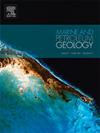Investigating key pressure loss factors in the Wufeng-Longmaxi formation shale gas reservoirs, Southern Sichuan: A quantitative approach
IF 3.6
2区 地球科学
Q1 GEOSCIENCES, MULTIDISCIPLINARY
引用次数: 0
Abstract
Pressure loss in the Wufeng-Longmaxi Formation shale gas reservoirs of the southern Sichuan Basin is a complex issue. This occurrence is influenced by several critical factors: faults, stratigraphic properties, fold structures, and the timing and magnitude of uplift events. While we know these factors are significant, their quantitative impact and individual contributions to pressure loss remain poorly understood. In this study, we integrate the burial and thermal history of the basin to reconstruct the evolution of key reservoir parameters, including formation temperature, hydrostatic pressure, overburden pressure, total porosity, water-filled porosity, and gas adsorption porosity. Using this framework, we simulate the effects of different preservation conditions on pressure loss within shale gas reservoirs and evaluate the relative contributions of these controlling factors. Simulation results revealed that the location of fault development, particularly its penetration through the caprock, is the predominant factor governing pressure loss in local shale gas reservoirs. In contrast, the scale of fault development has a relatively minor impact. Additionally, the thickness and vertical diffusion coefficient of the caprock, along with the time, emerged as secondary controlling factors that substantially influence the rate of pressure loss across the shale gas reservoirs. Furthermore, the dip angle of synclinal folds and the lateral diffusion coefficient act as accelerators of pressure loss, potentially leading to rapid depletion of reservoir pressure. Conversely, the properties of anticlines exhibit minimal influence on pressure loss. These findings provide valuable insights for the management and optimization of shale gas reservoirs in the Wufeng-Longmaxi Formation.
川南五峰组—龙马溪组页岩气储层压力损失关键因素定量分析
川南五峰组—龙马溪组页岩气储层压力损失是一个复杂的问题。这种产状受几个关键因素的影响:断层、地层性质、褶皱结构以及隆升事件的时间和幅度。虽然我们知道这些因素很重要,但它们对压力损失的定量影响和个人贡献仍然知之甚少。结合盆地埋藏史和热史,重建了地层温度、静水压力、覆盖层压力、总孔隙度、充水孔隙度和气体吸附孔隙度等关键储层参数的演化。在此框架下,模拟了不同保存条件对页岩气储层压力损失的影响,并评价了这些控制因素的相对贡献。模拟结果表明,断层发育的位置,特别是断层穿过盖层的位置,是控制局部页岩气储层压力损失的主要因素。相比之下,断层发育规模的影响相对较小。此外,盖层厚度和垂向扩散系数以及时间成为影响页岩气储层压力损失速率的次要控制因素。此外,向斜褶皱倾角和侧向扩散系数是压力损失的加速因素,可能导致储层压力快速衰竭。相反,背斜的性质对压力损失的影响最小。这些发现为五峰组—龙马溪组页岩气储层的管理与优化提供了有价值的参考。
本文章由计算机程序翻译,如有差异,请以英文原文为准。
求助全文
约1分钟内获得全文
求助全文
来源期刊

Marine and Petroleum Geology
地学-地球科学综合
CiteScore
8.80
自引率
14.30%
发文量
475
审稿时长
63 days
期刊介绍:
Marine and Petroleum Geology is the pre-eminent international forum for the exchange of multidisciplinary concepts, interpretations and techniques for all concerned with marine and petroleum geology in industry, government and academia. Rapid bimonthly publication allows early communications of papers or short communications to the geoscience community.
Marine and Petroleum Geology is essential reading for geologists, geophysicists and explorationists in industry, government and academia working in the following areas: marine geology; basin analysis and evaluation; organic geochemistry; reserve/resource estimation; seismic stratigraphy; thermal models of basic evolution; sedimentary geology; continental margins; geophysical interpretation; structural geology/tectonics; formation evaluation techniques; well logging.
 求助内容:
求助内容: 应助结果提醒方式:
应助结果提醒方式:


